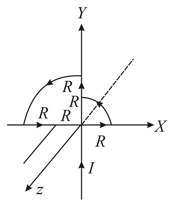Embibe Experts Solutions for Chapter: Magnetic Effect of Current, Exercise 4: Exercise-4
Embibe Experts Physics Solutions for Exercise - Embibe Experts Solutions for Chapter: Magnetic Effect of Current, Exercise 4: Exercise-4
Attempt the free practice questions on Chapter 25: Magnetic Effect of Current, Exercise 4: Exercise-4 with hints and solutions to strengthen your understanding. Beta Question Bank for Engineering: Physics solutions are prepared by Experienced Embibe Experts.
Questions from Embibe Experts Solutions for Chapter: Magnetic Effect of Current, Exercise 4: Exercise-4 with Hints & Solutions
The figure shows a conductor of weight and length placed on a rough inclined plane making an angle with the horizontal so that conductor is perpendicular to a uniform horizontal magnetic field of induction . The coefficient of static friction between the conductor and the plane is . A current of A flows through the conductor inside the plane of this paper as shown. What is the force needed to be the applied parallel to the inclined plane to sustaining the conductor at rest?
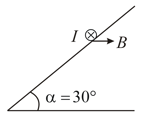
An electron gun emits electron of energy travelling in the -direction. The electron are required to hit the spot where & the line makes an angle of with the -axis, as shown in the figure. A uniform magnetic field parallel to exists in the region outsides to electron gun. Find the minimum value of needed to make the electron hit at .
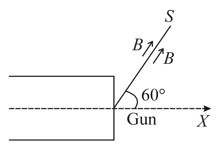
A square of side a is carrying the current . Then prove that the ratio of magnetic fields due to it are at centre to the vertex is .
Two long straight parallel wires are apart, perpendicular to the plane of the paper. The wire carries a current of , directed into the plane of the paper. The wire carries a current such that the magnetic field of induction at the point , at a distance of from the wire , is zero. Find
(i) The magnitude and direction of the current in .
(ii) The magnitude of the magnetic field due to induction at the point .
(iii) The force per unit length on the wire .
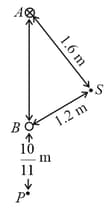
Two long parallel wires carrying currents and (amperes) in the same direction (directed into the plane of the paper) are held at and respectively such that they are perpendicular to the plane of paper. The points and are located at the distance of and repetitively from a collinear point (see figure).
(i) An electron moving with a velocity of along the positive -direction experiences a force of magnitude at the point . Find the value of .

(ii) Find all the positions at which a third long parallel wire carrying a current of magnitude A may be placed, so that the magnetic induction at is zero.
Two coils each of turns are held such that one lies in the vertical plane with their centres coinciding. The radius of the vertical coil is and that of the horizontal coil is . How would you neutralize the magnetic field of the earth at their common centre? What is the current to be passed through each coil? Horizontal component of earth's magnetic induction and angle of dip .
Figure shows a small magnetised needle placed at a point, , the arrow shows the direction of its magnetic moment. The other arrows show different positions (and orientation of the magnetic moment) of another identical magnetised needle .
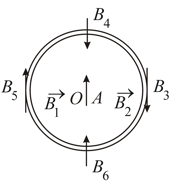
(i) In which configurations is the system not in equilibrium?
(ii) In which configuration is the system in stable, and unstable equilibrium?
(iii) Which configuration corresponding to the lowest potential energy among all the configurations shown?
Find the magnetic induction at the origin in the figure shown.
